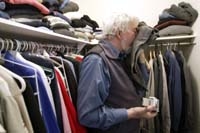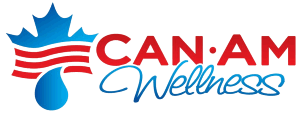The air we breathe Part 3
The air we breathe Part 3 – No sanctuary in home, sick home
High dust load, poisonous cleaners, no fresh air a toxic combo
MEGAN GILLIS
The Toronto Sun – Wednesday, June 1, 2006

Jim White, an engineer and consultant who tests homes’ indoor air quality, sniffs a sweater during a visit to a new townhouse. (SEAN KILPATRICK Sun Media)
So did the owners of a typical suburban Ottawa townhouse shared by a family of four — including a toddler with asthma — and so new the only traffic outside is bulldozers.Think your home is healthy?
But that wasn’t the conclusion of engineer Jim White, who sealed himself in the family’s closets, buried his face in their beds and got on his hands and knees behind the furnace.
“This house is sick enough to make poor Daniel ill,” White says of the family’s 18-month-old son.
“It’s 80th percentile as far as being towards a healthy home but it has critical failures — no fresh air, a high dust load and use of poisonous products.
“That combination is deadly for little kids.”
This typical home has all-too-typical problems, White says.
He knows his houses. Now a private consultant, he spent decades studying housing at the Canada Mortgage and Housing Corporation and taught at CMHC’s air investigator training program, the only one of its kind.
He pioneered the now-ubiquitous idea of the home as a system in which all the parts have to work together.
Homeowners Greg and Michelle are doing their best to keep the home “unbelievably” clean but what they are doing to keep the surfaces spotless — including vacuuming with the wrong machine and using toxic cleaning products — is making the air dirty, White said.
Before White even went inside, he spotted trouble.
The house has no eavestroughs — they’re not required by the building code — and that allows water to pool next to the foundation, risking a basement leak that would breed mould.
Nor is there a heat recovery ventilator — again, it’s not required — to constantly bring fresh air into the house.
And there’s no shield to protect the gas regulator from falling ice, which could cause a potentially tragic failure.
Inside, White sniffs and explains that the “new house” smell is formaldehyde from off-gassing building materials, oriented strandboard floor joists and new carpeting.
In the basement, he finds damp patches that suggest a leak and discovers the house is too humid — 54% when it should be below 45% — increasing off-gassing from building materials and encouraging dust mites and mould.
“This house definitely needs a dehumidifier,” he says.
White discovers that the fresh air duct next to the furnace — required by code — isn’t working. The only source of fresh air in an airtight house is useless.
Upstairs, White finds more trouble. The ventilation fan in the master bathroom — where two adults shower and use a massive soaker tub — won’t even lift a tissue in a low-tech test.
In the bedroom, he buries his head in the homeowners’ sheets to check for dust mites and demonstrates the right way to make a bed. He throws the quilt back to allow the sheets to air and props the pillows on their ends.
“Unmake your bed every morning. Throw back the covers and ventilate,” he says.
“During a typical night, the man releases a third to half a litre of water and a woman half that. It has to go somewhere.”
White recoils when he opens the laundry cupboard, full of different kinds of detergent, bleach and fabric softeners. He finds stashes of smelly cleaners under every sink.
“It smells nice but it’s poison,” White says.
In the toddler’s bedroom, he grimaces at the dust.
“Michelle is taking extra care to vacuum this room, but every time she vacuums she’s pulling more fine dust into the air,” White says. “His asthma will dramatically improve when you get some air into the house, stop using the toxic chemicals and vacuum with something that actually removes the dust.”
White’s recommendations range from money-saving to pricy.
The family could save money by switching from toxic cleaners to vinegar, baking soda and water, for example.
“Often some of the highest-ranked things to do are low or no cost,” White says. “For Michelle, it’s getting rid of her toxic cleaners and air fresheners.”
But he also recommends some costlier measures, including installing a heat recovery ventilator, a dehumidifier and a central vacuum system or buying a High Efficiency Particulate Arresting (HEPA) vacuum cleaner.
He argues the changes are worth it for health and comfort.
“My conclusion is this house is not a healthy house but it can be made into one,” he says.
“The bad news is Daniel’s problems are a result of problems with the home. But they can be fixed — or you can save your money for your health bills and being off work.”
